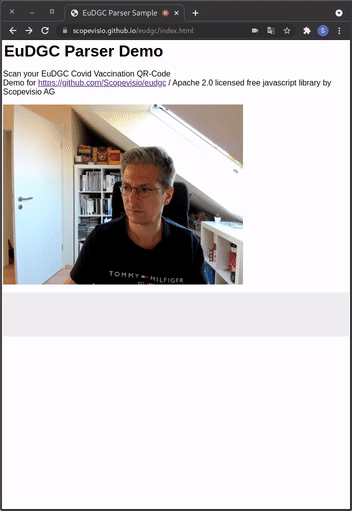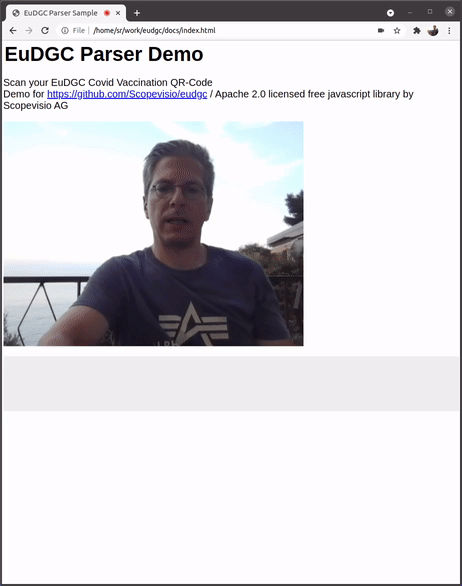A pure javascript (or typescript) library for parsing and validating the European Digital Green Certificate (EuDGC) better known as the "Digitaler Impfpass" in germany or "Digital COVID Certificate or even "Covid Vaccination Pass/QRCode" in other places.
Licensed to the Apache Software Foundation (ASF) under one or more contributor
license agreements; and to You under the Apache License, Version 2.0. "
The certificate is typically provided in form of a QR-Code. This library deals with the contents of this QR-Code. The QR-Code recognition must be done using some other tools or libraries.
Use this application for reference and as an example. This sample is intended to be a full minimalistic example and is found in the index.html in the docs/ folder.
The EuDGC Certificate is a Base45 encoded, Zlib-compressed, Cbor structure. The Cbor structure itself confirms to the COSE Standard, which is an extension of Cbor that provides signatures.
The EuDGC Certificate is signed using an X509 signature. Apparently only the signatures are considered valid that are provided by the following url:
The certificate that signed the TLS certificate of this site was issued by D-Trust GmbH. D-Trust is a subsidary of the Bundesdruckerei Gruppe (German government agency for printing).
Basically a EuDGC-COVID certificate is thus valid when it was digitally signed by one of the certificates in the trustlist. The X509 cerficates can be obtained by saving the contents of the "rawData" property and decoding the base64 to binary. After that a certicate can be viewed using
openssl x509 -inform der -text < your_binary_data.bin
The publickeys are part of the X509 certificates of course. Using openssl or other cryptolibraries you can also convert those certificates into the more common PEM format.
Available on npm. Can be used in a Node.js program or with a module bundler such as Webpack or Browserify.
npm install eudgc --save
// ES6 import (preferred)
import { EuDgc, EuDgcCert, EuDgcVaccination} from 'eudgc'
let qrCode = "HC1....";
try {
let certificate = EuDgc.parse(qrCode);
// ....
} catch (error) {
console.log("not a eudgc qrcode: " + error)
}Alternatively you can include the .js bundle in your browser via a good old script tag.
<script src="eudgc.js"></script>
<script>
let qrCode = "HC1....";
try {
let certificate = EuDgc_parse(qrCode);
// ....
} catch (error) {
console.log("not a eudgc qrcode: " + error)
}
</script>Eudgc defines a parsing and a validation method on the window object that takes a single argument. Of course when running outside of a browser you should just use the ES6 imports. Typescript is recommend, but plain javascript will work just the same.
// Using the global function on window in browser
EuDgc_parse(qrCode);
EuDgc_validate_(qrCode);
// if you want to filter the list of certificates you can
// use the options object to pass in a predicate function indicating
// whether any given certificate is to be used ...
// here all certs are considered true.
EuDgc_validate(qrCode, {
certFilter: (certInfo) => { return true; }
});// When using typescript and/or ES6 modules
EuDgc.parse(qrCode);
EuDgc.validate(qrCode);
// if you want to filter the list of certificates you can
// use the options object to pass in a predicate function indicating
// whether any given certificate is to be used ...
// here all certs are considered true.
EuDgc.validate(qrCode, {
certFilter: (certInfo) => { return true; }
});The available options for the validate-method are:
/*
* Object that contains the available options to the validate method.
*
* You can pass in a filter on what certificates to use
* or an explicit list of certificates. See below for available options.
*
*/
export interface ValidationOptions {
/* certFilter: is an optional filter predicate function. It is passed each
* certInfo and should return false for certificates that should be skipped
* during validation. If the certFilter is undefined or null, then all
* certs will be used for validation.
*/
certFilter?: (certInfo: CertInfo) => boolean;
/* explicitCerts: an optional array of certificates to use for
* validation. this allows to pass in more recent certificates or other
* certificates.
*
* Please note that one can obtain wrong and invalid(!)
* results by doing so. The responsibility to only indicate really
* valid certificates as valid in your product is up to you.
* This is also potentially usefull for debugging.
*/
explicitCerts?: CertInfo[];
}
The single argument is the qrcode contents in form of a string. The string can be prefixed with HC1 optionally. Then this prefix is handling correctly but it is not necessary to provide.
If a QR-Code was successfully decoded the library will return an object of the following structure:
/*
* eudgc record
*
* contains an array of vaccinations
* and user information
*
* however if this is to be transported inside a qrcode, most
* likely there will be only one vaccination
*/
export interface EuDgcCert {
"v": EuDgcVaccincation[]; // an array of vaccinations, probably just 1 right now
"dob": string; // date of birth "1970-01-31",
"nam": {
"fn": string; // familiy name
"gn": string; // firstname
"fnt": string; // fn in caps and without Umlauts
"gnt": string; // gn in caps and without Umlauts
};
"ver": string; // "1.0.0" ?
}
/*
* eudgc vaccination record
*
* full immunization is given when { dn == sd }
*/
export interface EuDgcVaccincation {
"ci": string; // "URN:UVCI:01DE/....." Unique Certificate Identifier: UVCI
"co": string; // "DE", vaccination number
"dn": number; // 1, 2 ... number of dose
"dt": string; // "2021-02-28", date of vaccination
"is": string; // eg "Robert Koch-Institut", issuer
"ma": string; // Marketing Authorization Holder - if no MAH present, then manufacturer
"mp": string; // Vaccine medicinal product
"sd": number; // Total Series of Doses
"tg": string; // Disease or agent targeted
"vp": string; // Vaccine or prophylaxis
}Note that a person is fully vaccinated when dn == sd and in most interpretation if the date of vaccination is at least 10 days old.
The single argument is the qrcode contents in form of a string. The string can be prefixed with HC1 optionally. Then this prefix is handling correctly but it is not necessary to provide.
The validation of a QR-Code will return null in case of failure or an object of the following structure in the case of success:
/* Certificate information. This informatino identifies the certificate
* that has validated the given QR-Code. The certificate is a X509
* standard certificate, however this datastructure provides convenient fields.
*/
export interface CertInfo {
subject: string; // subject of the certificate
issuer: string; // string that describes the issuer of the certificte
notbefore: number; // date before which the certificate should be considered invalid given as a timestamp
notafter: number; // date after which the certificate should be considered invalid given as a timestamp
pubkey: string; // the publickey of the certificate in a way that the browser-crypto api can process it
rawX509data: string; // the X509 certificate in binary DER format, encoded as base64
// the rawX509 string contains all the other fields, but needs to be decoded to access that information
// one way to do that is using openssl -inform DER -text
}Note that the certinfos are provided as part of this package statically. You probably should check for their validity yourself by loading the data from
https://de.dscg.ubirch.com/trustList/DSC/
and converting it appropriately. However the crypto.createVerify() method only accepts certain publickey formats and you'd probably need to add some more crypto libraries for javascript if you want to do all of that in the browser. In my opinion it is enough to update the trustlist on a daily basis by invoking
curl https://api.undo-app.de/getcerts -H 'Accept: application/json' -H 'Content-Type: application/json;charset=UTF-8' --data-raw '{"includeraw": true}'
and using the obtained data straight instead of the data provided in the file certs.json.
You can convert the timestamps given as numbers into Javascript Date Objects like this
let notBefore = new Date(certinfo.notbefore)
...
Eudgc is written using typescript.
You can view the development source in the src directory.
Typescript, webpack and everything else is defined to be a development dependency. Using the npx command that comes with node.js the typescript and webpack binaries from the project can be used. This is the intended way. The scripts inside package.json use npx to perform the various tasks.
// for building a production build use
npm run build
// for development use
npm run serve
- Source hosted at GitHub
- Report issues, questions, feature requests via email to [email protected]
Pull requests and all sorts of improvements are welcome. However this project should just provide the basic EuDGC parsing and validation. Other functionality belongs in other projects.
This project is sponsored by Scopevisio AG / Bonn.
/Stepan

